Cuisine of the Southern United States
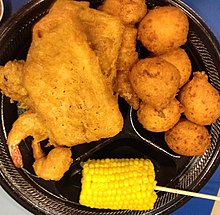
| Part of a series on |
| American cuisine |
|---|
 |
The cuisine of the Southern United States encompasses diverse food traditions of several subregions, including
Many elements of Southern cooking—
Many Southern foodways are local adaptations of Old World traditions. In Appalachia, many Southern dishes are Scottish or British Border in origin. For instance, the South's fondness for a full breakfast derives from the British full breakfast or fry-up. Pork, once considered informally taboo in Scotland, has taken the place of lamb and mutton. Instead of chopped oats, Southerners have traditionally eaten grits, a porridge normally made from coarsely ground maize.
Certain regions have been infused with different Old World traditions.
Sources
There is danger that the composition of many an excellent dish may become forgotten lore.
Virginia Cookery Book (1885)
Interest in American regional cooking continued to grow after the Civil War, especially concerning the traditions of the Southern United States. Many new cookbooks were added to the existing body of literature. Some of these fell within the scope of domestic manuals offering instruction to southern homemakers to the maintenance of homes in the new post-Slavery era. Some of these works like Mary Stuart Smith's Virginia Cookery Book (1885) aimed to preserve the culinary heritage of the South.
Traditional Southern dishes
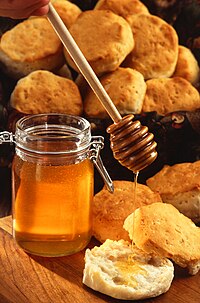
A traditional Southern meal may include pan-
Other Southern foods include
Barbecue
"White barbecue sauce" made with mayonnaise, pepper and vinegar is a specialty of Alabama barbecue usually served with smoked barbecue chicken.[4]
"Yellow barbecue sauce" made with a mustard base is unique to South Carolina barbecue and has roots in the mass immigration of Germans to the area in the mid-1700s.[5]
Fried chicken
Fried chicken is among the region's best-known exports. It is believed that the Scots, and later Scottish immigrants to many southern states had a tradition of deep frying chicken in fat, unlike their English counterparts who baked or boiled chicken.[6][7][8][9][10] However, some sources trace the origin of fried chicken to Southern and Western England where most of the Early settlers to the South came from. They conclude that Southern and Western England had a strong tradition of frying, simmering, and sautéing meats in a skillet as opposed to East Anglia which favored baking and boiling meats.[11][12]
The importance of fried chicken to southern cuisine is apparent through the multiple traditions and different adaptations of fried chicken, such as
Pork and ham
Pork is an integral part of the cuisine. Stuffed ham is served in Southern Maryland.[17] A traditional holiday get-together featuring whole hog barbecue is known in Virginia and the Carolinas as a "pig pickin'".
Green beans are often flavored with
Country ham, a heavily salt-cured ham, is common across the Southern United States, with the most well-known being the Virginia-originating Smithfield ham.[19]
Vegetables

Southern meals sometimes consist only of vegetables, with a little meat (especially salt pork) used in cooking but with no meat dish served. "Beans and greens"—white or brown beans served alongside a "mess" of greens stewed with a little bacon—is a traditional meal in many parts of the South (Turnip greens are the typical greens for such a meal; they're cooked with some diced turnip and a piece of fatback).
Other low-meat Southern meals include beans and cornbread—the beans being pinto beans stewed with ham or bacon—and Hoppin' John (black-eyed peas, rice, onions, red or green pepper, and bacon).
Cabbage is largely used as the basis of coleslaw, both as a side dish and on a variety of barbecued and fried meats.[20] Sauteéd red cabbage, flavored with vinegar and sugar, is popular in German-influenced areas of the South such as central Texas.
Rice
Red Rice is another staple of Low Country southern cuisine, which is a rice dish simmered in tomato paste, usually cooked with bacon, onion, and other spices
Sweets and pastries
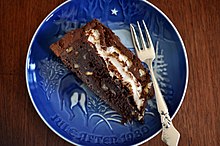
Georgia is known for peach cultivation and variations of
Seafood
Gulf seafood like
Southern food in restaurants
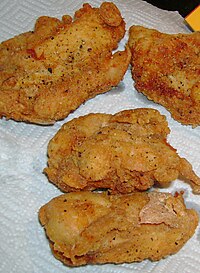
Chains serving Southern foods—often along with American
By region
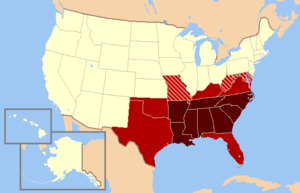
Southern cuisine varies widely by region. Generally speaking:
- Appalachian areas have many ramps (a variety of wild onion) and berries. Appalachia uses butter extensively but makes little use of cheese, and eats more wild game (as well as wild fruits and vegetables) than the rest of the South; apples, oats, and potatoes are also common in Appalachian cuisine, since the mountains are cooler and drier than the lowlands.
- The Upper South favors pork and whiskey; the Low Country (the coast, especially coastal Georgia and coastal South Carolina) favors seafood, rice, and grits.
- Texas and Oklahoma tend to prefer beef; the rest of the South prefers pork.[24]
- Arkansas is the top rice-producing state in the nation. It produces Riceland rice and sweet corn, both of which are staples of the cuisine of Southeastern Arkansas.[25] Arkansas is also noted for catfish, pork barbecue at restaurants, and chicken.
- Florida is home of the Key lime pie and swamp cabbage. Orange juice is the well-known beverage of the state. It has a large beef industry, as well as a seafood industry, and both are reflected in local cuisine. Rock shrimp is beloved on the coast, while beef is common in the state's interior. Due to its long-term economic and trading relationship with the rest of the Caribbean, a particular form of fusion cuisine known as Floribbean cuisine has developed in the state, a fusion of traditional southern food with Caribbean cuisine, often relying on both peppers and fruit to flavor meat dishes.
- Georgia is known for its peaches, pecans, peanuts, and Vidalia onions.[26]
- In Southern Louisiana, there is
- Kentucky is famous for Burgoo, beer cheese, and the Hot Brown. Kentucky is also known for KFC and fried chicken.
- Smith Island Cake.[28]
- Mississippi and Alabama produce the most catfish in the United States.[29]
- Carolina-style barbecue is common in North Carolina, South Carolina, and Virginia, and is made traditionally from pulled-pork and a vinegar based sauce.
- Southwest Virginia has a reputation for many grain- and bean-based dishes, such as "cornbread and beans" or the breakfast dish biscuits and gravy. Mississippi specializes in farm-raised catfish, found in traditional "fish houses" throughout the state.
- In the coastal areas of South Carolina, rice was an important crop, leading to local specialties like "Hoppin' John" (a mixture of rice and black-eyed peas flavored with salt pork) and Charleston red rice.
- Memphis is known for several famous barbecue restaurants and a major barbecue cooking competition held in May. Memphis barbecue usually consists of pork and is distinct for its dry rub. No sauce is applied during the cooking process instead flavor is gained from the rub when cooking.[31] Nashville is known for its famous hot chicken from places like Prince's Hot Chicken Shack, Bolton's Hot Chicken,[32] Hattie B's, and Biscuit Love.[33] Nashville is also home to the restaurant Husk run by world-class chef Sean Brock.
- Texas specializes in barbecue, chili, and Southern cuisine as well as a regional variation of Mexican food unique to Texas called Tex-Mex.
- Virginia produces Smithfield ham[34] and Virginia peanuts. Brunswick stew, which originated in the town of Brunswick, Virginia is also popular. The state's proximity to the Chesapeake Bay and the ideal conditions of the Rappahannock River, makes oysters a popular dish in Virginia, be they served fried, raw, or in a cream-based oyster stew.
- West Virginia is the area where pepperoni rolls are most popular, which typically consists of a white bread roll with pepperoni baked in the middle. The fats in the pepperoni melt into the bread, giving the bread an extra dimension of flavor. Other ingredients are sometimes added, such as cheese, peppers, or melted butter on top.
Louisiana Creole cuisine

Southern
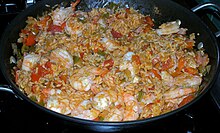
Lowcountry cuisine
The Lowcountry region of the coastal Carolinas and Georgia shares many of the same food resources as the Upper Gulf Coast: fish, shrimp, oysters, rice, and okra. It also displays some similarities to Creole and Cajun cuisines.
Appalachian cuisine

Because of its geographic location, Appalachia cuisine offers a wide range of ingredients and products that can be transformed using traditional methods and contemporary applications.
European fruits—especially
19th-century meals included greens fried in
Coffee, drunk without milk and only lightly sweetened, is a basic drink in Appalachia, often consumed with every meal; in wartime, chicory was widely used as a coffee substitute.
Rice and cane sugar, grown further south, were not easy to come by in Appalachia and generally sorghum, honey and maple syrup were used as sweetener in local dishes.[39] Travel distances, conditions, and poor roads limited most early settlements to foods that could be grown or produced locally.
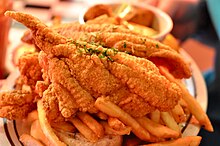
For farmers,
However,
Home
Dried pinto beans are a major staple food during the winter months, used to make the ubiquitous ham-flavored bean soup usually called soup beans. Kieffer pears and apple varietals are used to make pear butter and apple butter.
Also popular are
As
The gravy for biscuits and gravy is typically sausage or sawmill, not the red-eye gravy (made with coffee) used in the lowland South.
See also
- Bahamian cuisine
- Barbecue
- Cuisine of the Southwestern United States
- Cuisine of the United States
- Liberian cuisine
- List of foods of the Southern United States
- Soul food
- Southern Food and Beverage Museum
- Tex-Mex cuisine
- Memphis-style barbecue
- Texan cuisine
- Cuisine of New Orleans
- Cuisine of Kentucky
- Cuisine of Houston
- Cuisine of Atlanta
References
- LCCN 2009003907.
- ISBN 978-0-8139-1774-0.
- ISBN 978-1560980599.
- ^ a b c d e Southern Living No Taste Like Home: A Celebration of Regional Southern Cooking and Hometown Flavors.
- ^ Lake E. High Jr. (2019). "A Very Brief History of the Four Types of Barbeque Found In the USA". South Carolina Barbeque Association. Archived from the original on 13 March 2017.
- ^ "Southern fried". Enquirer.com. Retrieved 2009-06-20.
- ^ "Southern favorites". Southernliving.com. Retrieved 2016-01-05.
- The Food Timeline. Retrieved 2009-06-20.
- ISBN 978-0-252-03185-4.
- ^ Miller, Adrian. "The surprising origin of fried chicken". BBC Travel. BBC.com. Retrieved 8 January 2021.
- ^ "Dorothy Hartley, Food in England (London, 1954) 174."
- ^ Hackett Fischer, David. Albion's Seed Oxford University Press, 1989.
- ^ Ugly Delicious. "Fried Chicken." Episode 6. Directed by Eddie Schmidt. Written by Danny Breen. Netflix, February 23rd, 2018.
- ^ "Southern fried". Enquirer.com. Retrieved 2009-06-20.
- ^ "Southern favorites". Southernliving.com. Retrieved 2016-01-05.
- ^ Lynne Olver. "history notes-meat". The Food Timeline. Retrieved 2009-06-20.
- ^ Gray, Mary Z. (5 December 1982). "Stuffed Ham With A Kick". The New York Times. Retrieved 31 July 2012.
- ISBN 9780307834560. Retrieved 2020-06-13.
- ^ Dan Nosowitz (2016-12-24). "Check Out These Sick Hams From Around The World". Modern Farmer. Retrieved 2020-06-13.
- ^ Villas, James. The Glory of Southern Cooking", John Wiley & Sons, Hoboken, NJ, 2007, p. 73
- ^ McDermott, Nancie (2010-07-01). Southern Pies: A Gracious Plenty of Pie Recipes, From Lemon Chess to Chocolate Pecan. Chronicle Books. pp. 41–42.
- ^ David Williamson. "UNC-CH surveys reveal where the 'real' South lies". Retrieved 22 February 2007.
- ^ "Archived copy". www.pfly.net. Archived from the original on 11 April 2020. Retrieved 13 January 2022.
{{cite web}}: CS1 maint: archived copy as title (link) - ^ "Texas Vs. Everyone else: The Great Beef vs. Pork BBQ Debate". 23 October 2014.
- ^ "Encyclopedia of Arkansas". Encyclopedia of Arkansas. Retrieved 2020-06-13.
- ^ "Georgia's Famous Foods You Just Have to Try when You Visit". Retrieved 2020-06-13.
- ^ Thier, Dave (December 5, 2012). "In Louisiana, Growing Rice to Trade on Some Creatures That Eat It". The New York Times. New York City. Retrieved July 10, 2016.
- ^ "September is the best month for blue crabs". 31 August 2017.
- ^ "Alabama Catfish Producers | Alabama Farmers Federation | ALFA Farmers Federation". alfafarmers.org. Archived from the original on 2016-08-24. Retrieved 2016-08-11.
- ^ "History". www.interstatebarbecue.com. Retrieved 2022-04-26.
- ^ "The Four Regional BBQ Styles of Today". Dyer's BBQ. 2020-06-12. Retrieved 2022-04-26.
- ^ "Bolton's Spicy Chicken & Fish". Roadfood. Retrieved 2021-03-21.
- ^ Naomi Tomky (December 29, 2016). "Eat, Stroll, Repeat: A Walking Tour of Nashville's Best Food". Traveler.
- ^ "Legislative Information System". leg1.state.va.us. Retrieved 16 October 2017.
- ISBN 978-1-4696-1652-0.
- ISBN 978-0-8147-8916-2.
- ISBN 978-0-19-967733-7.
- ^ Ronni Lundy, "Publication | Ronni Lundy". ronnilundy.com. Archived from the original on 31 May 2012. Retrieved 26 September 2019.
- ^ a b c d Mark F. Sohn, Appalachian home cooking. pp. 8–15.
- ^ Abramson, Rudy and Jean Kaskell (eds.), Encyclopedia of Appalachia, Univ. of Tennessee Press, Knoxville, TN, 2006 pp. 917, 955,1387–1389
- JSTOR 26635117.
- ^ "G&G's Fast-Food Breakfast Biscuit Taste Test – Garden & Gun". Gardenandgun.com. 22 January 2016. Retrieved 16 October 2017.
- ^ "Map: McDonald's all-day breakfast pits muffins against biscuits". Nrn.com. 5 October 2015. Retrieved 16 October 2017.
- Bowen, Carl. Southern-Recipes. 2010. ISBN 978-1-4563-4479-5.
- Domine, David. 111 Fabulous Food Finds: Best Bites in the Bluegrass. McClanahan Publishing House, 2011. ISBN 978-1-934898-12-3.
- Domine, David. Adventures in New Kentucky Cooking with the Bluegrass Peasant. McClanahan Publishing House, 2007. ISBN 0-913383-97-X.
- Domine, David. Splash of Bourbon, Kentucky's Spirit. McClanahan Publishing House, 2010. ISBN 978-1-934898-06-2
- Harris, Jessica. On the Side: More than 100 Recipes for the Sides, Salads, and Condiments That Make the Meal. Simon & Schuster, 2004. ISBN 0-7432-4917-8.
- The Junior League of Charleston. Charleston Receipts. Wimmer Brothers, 1950. ISBN 0-9607854-5-0.
- Lewis, Edna and Peacock, Scott. The Gift of Southern Cooking: Recipes and Revelations from Two Great American Cook. Knopf, 2003. ISBN 0-375-40035-4.
- Neal, Bill. Bill Neal's Southern Cooking. University of North Carolina Press, 1989. ISBN 0-8078-4255-9.
- Neal, Bill. Biscuits, Spoonbread, and Sweet Potato Pie. University of North Carolina Press, 2003. ISBN 0-8078-5474-3.
- Neal, Bill. Good Old Grits Cookbook. Workman Publishing Company, 1991. ISBN 0-89480-865-6.
- Snow, Constance. Gulf Coast Kitchens. Clarkson Potter/Publishers, 2003. ISBN 0-609-61011-2.
- Sohn, Mark F. Appalachian Home Cooking History, Culture, & Recipes Lexington: University Press of Kentucky. 2005. ISBN 0-8131-9153-X
- Taylor, John. Hoppin' John's Lowcountry Cooking. 1992. ISBN 0-553-08231-0.
- Walter, Eugene. American Cooking: Southern Style. New York: Time Life Books, 1971.
Further reading
- Wilson, Charles Reagan (2007). Edge, John T. (ed.). The New Encyclopedia of Southern Culture Volume 7: Foodways. University of North Carolina Press. .
- Ferris, Marcie Cohen (2014). The Edible South: The Power of Food and the Making of an American Region. Chapel Hill, NC: University of North Carolina Press.
